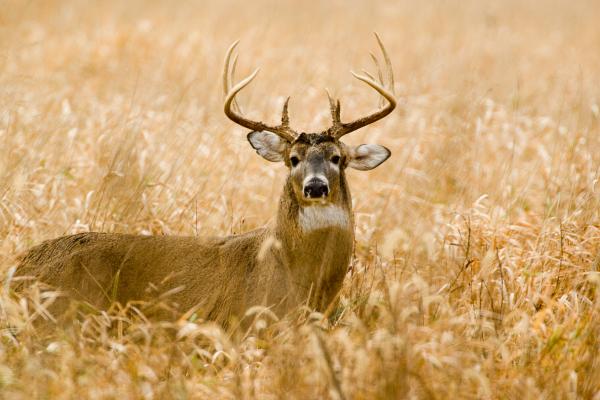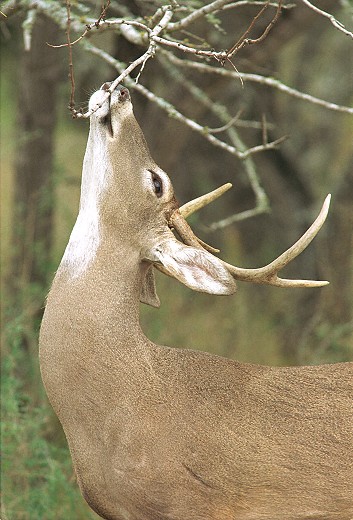White-tailed deer are “browsing” animals. They eat a wide variety of foods and the food selected will depend on its availability, abundance and the season of the year. No one food is eaten in great amounts throughout the year.
By the Missouri Department of Conservation
 These facts must be considered when attempting to improve or manage deer habitat. Food studies indicate a marked change in feeding habits from summer to winter. Management should be directed toward insuring adequate food supplies during all seasons of the year.
These facts must be considered when attempting to improve or manage deer habitat. Food studies indicate a marked change in feeding habits from summer to winter. Management should be directed toward insuring adequate food supplies during all seasons of the year.
Spring and Summer Browse
The main food during the summer period is the leafy parts of annual and perennial weeds and shrubs. Deer show a preference for summer grape, red clover, Virginia creeper and Korean lespedeza, during this period.
The top 14 summer foods (in order of importance) indicated by a food habits study are:
- Summer Grape
- Red Clover
- Virginia Creeper
- Korean Lespedeza
- Winter Grape
- American Elm
- Dwarf Sumac
- Fragrant Sumac
- Prickly Lettuce
- Fungi
- Slippery Elm
- River-Bank Grape
- Canada Lettuce
- White Oak (Acorns)
Most preferred foods are considered “edge species.” Habitat management for deer summer foods must include any activity that increases plant diversity.
Fall and Winter Foods
Deer food habits change abruptly in autumn when acorns begin to fall. The amount and quality of acorns will determine how much deer will feed on agricultural crops, sumacs, buckbrush, etc. If acorns are in short supply, deer will feed heavily on corn, lespedeza, wheat and other crops.
Primary winter foods (in order of importance) are:
- Acorns (black and white oak)
- Corn
- Buckbrush (Coralberry)
- Sumacs
- Korean Lespedeza
- Grass and Sedges
- Ladies Tobacco
- Weeds (Misc.)
- Winter Wheat
- Eastern Red Cedar
- Honeylocust
The annual production of acorns in Missouri varies from year to year, with some years being nearly a complete failure. Acorns are heavily consumed when available and are an important source of energy. However, good habitat management should ensure that adequate alternate foods are available when a mast failure occurs.
GAME CAMERAS PROVIDE YOU A WILDLIFE INVENTORY! Click here
The Woodlot
The oaks have special wildlife values for both food and cover. Young oaks with branches close to the ground provide brushy cover. In addition, there is evidence that dried oak leaves are important in the winter diet of white-tailed deer.
Approximately 54 percent of the deer’s year-round diet is acorns. To ensure a good supply of acorns, mature trees of several oak species should be maintained. Seven oaks that contribute a large part of the fresh acorn supply in Missouri are post, black, white, northern red, chinquapin, blackjack and scarlet.
 To fulfill the acorn demands of forest wildlife including deer, 19 to 20 mast producers per acre are required. These trees should average 14 inches in diameter to be able to produce around 4 1/2 pounds of acorns per tree or 85 pounds per acre. The number of acorns produced by each tree depends on its crown size, age, health and the weather.
To fulfill the acorn demands of forest wildlife including deer, 19 to 20 mast producers per acre are required. These trees should average 14 inches in diameter to be able to produce around 4 1/2 pounds of acorns per tree or 85 pounds per acre. The number of acorns produced by each tree depends on its crown size, age, health and the weather.
Creating “brush” is the most commonly used technique for improving white-tailed deer habitat. The brush stage or seedling/sapling forest will provide three times the amount of twig production (or browse) than will a saw timber stand. The most common and most economical method of creating this habitat type is through timber harvesting. Timber harvest removes the leafy canopy so more sunlight reaches the ground. A new growth of young trees and forage provides food and cover for deer for about 10 years. After that time, increased shading by the closing of the new forest canopy once again reduces the quantity of desirable understory forage.
Shrubs and vines comprise another type of brushy cover. Shrubs can be encouraged to grow by removing some of the larger trees, which allows more sunlight to reach the understory. Some food producing shrubs which commonly occur in the understory are: Blueberry, flowering dogwood, witch-hazel, serviceberry, and viburnum.
THE BEST PRUNING SAW YOU’LL HAVE IN THE WOODS! Click here now!
Desirable wildlife shrubs and vines that need nearly full sunlight are: Blackberry, crab apple, grape, raspberry, greenbriar, hazel and hawthorn. Although these species may fare well at the forest’s edge, they will not grow well in the understory without vigorous thinning of the overstory.
The woodlot should be fenced to exclude livestock because livestock compete directly with deer for available understory forage.
Green Browse Plot
High-quality food can be provided in one acre plots near good cover. Lush stands of wheat and clover will attract deer (turkey and rabbits, also) when other foods are scarce. Prepare a good seedbed in August. Fertilize and lime according to soil test.
Seed the area with wheat at the rate of 1/2 bushel per acre, along with 5 pounds per acre of either inoculated alfalfa, ladino clover, red clover, or hairy vetch, or 2 pounds per acre of birdsfoot trefoil. The wheat will die after the first year, but the legume should persist and furnish succulent browse for three to five years.
CHECK THIS GREAT DEAL ON WILDLIFE SEEDS! Click here now!
Clip twice each year (about June 20 and Sept. 1) and top dress the plot with 100 pounds of phosphate and 100 pounds of potash every other year to add additional years of life to the planting.
Evergreens
Evergreens are important to deer. They provide valuable shelter, escape cover and food during winter. Conifer plantation of cedar and pine as small as 5 acres provide excellent shelter for deer once the trees are 10 to 15 feet high. Conifers continue to provide valuable cover until the lower, living branches are 15 to 20 feet off the ground and the understory becomes very open.
Water
Deer use water daily. Their water needs are partially supplied by succulent plants. Lack of free water on dry ridges may deter deer from using these areas.
A minimum of one source of permanent water per square mile (the approximated home range of a deer) is needed to secure year-round use of the available deer range.
Cover
Cover requirements of deer appear to be related to the animal’s need for seclusion and escape. A good interspersion of cover is essential within the home range of a deer. During the summer months, deer will usually be found wherever sufficient food, water, solitude and cover exist.
Favored winter cover contains evergreen foliage for concealment and protection from weather, as well as for food. Cover on south slopes and in hollows offers the best protection from weather.
Home Range
A deer’s home range is usually small, seldom encompassing more than one square mile. However, seasonal adjustments in home range may be common in response to changing food and cover conditions.
Yearlings, especially bucks, are more likely to make permanent changes in range than are adult deer. Adult deer are reluctant to move out of their home range to reach better food or cover, thus making it desirable that these features be well distributed within their home range.
Carrying Capacity
Carrying capacity as applied to deer can be defined as the number of animals which a given unit of land area can support without deterioration of the forage resource.
A population is limited in size by the factor(s) which exerts the greatest resistance to continued growth. Food, cover, water, human interaction and dogs are some of the more important factors limiting population growth of deer.
In Missouri forests, the carrying capacity for deer is most often limited by the quantity and quality of food. Preferred foods must not only be present in sufficient quantity, but their nutrient content and digestibility (or quality) must be considered when appraising carrying capacity. Protein is deficient in winter and phosphorus is deficient year round in several preferred foods of Ozark deer.
Summer foods are 1.5 times more digestible than winter foods; cellulose is over 4 times more digestible in summer than in winter. Thus, even when ample amounts of browse are available, deer may be poorly nourished. However, in winter, quantity of forage is a more important limiting factor than quality.
Energy may be the most important limiting factor in the forest. Deer are apparently in a negative energy balance and lose weight during most winter. Feeding studies of penned deer show that deer voluntarily decrease food consumption and lose weight during winter. Deer have apparently adapted through evolutionary time to poor quality and quantity of winter foods and depend on fat reserves deposited in late summer and fall to supply much of their winter energy needs.
Good summer and fall nutrition may be critical to winter survival and successful production of healthy fawns the following spring. Acorns are an important energy source during late summer and fall and this probably explains their heavy consumption rate by deer. A late summer drought followed by an acorn failure could be critical for deer in the Missouri Ozarks.
In some cases, deer populations never reach levels that fully utilize the available food. Here, limiting factors other than food cause low deer numbers. Free-running dogs, poaching, and lack of cover or water are examples of such factors.
Populations and the Role of Hunting
Without control, deer populations tend to increase until they exceed the food supply. Range destruction and starvation follow over-population. Therefore, some means of control is needed to keep deer numbers in balance with their food supply. Man must control deer numbers in Missouri, because most natural predators have been eliminated. Hunting is the most effective means of achieving this control. Therefore, hunting plays an important role in deer population management.
Source: Missouri Department of Conservation
